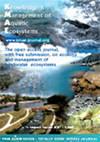欧洲鲤鱼(Cyprinus carpio)池塘中大型底栖动物的组合模式——新出现的大型植物床的重要性
IF 1.7
3区 环境科学与生态学
Q3 FISHERIES
引用次数: 8
摘要
鲤池沿岸大型底栖动物分布的质与量差异LM)和远洋区(无大型植物区;在2016年和2017年的生长季节(6 - 9月),对捷克共和国(半集约化管理)和奥地利(有机管理)的4个商业鲤鱼(Cyprinus carpio)生长池进行了月度MF评估。LM与MF的环境参数和颗粒组成差异无统计学意义(p > 0.05),但LM的有机质含量显著高于LM (p < 0.05)。LM的大型底栖动物平均密度和生物量(平均431 ind.m−2和6.78 g.m−2)显著高于MF (371 ind.m−2和3.17 g.m−2)(p > 0.05)。底栖动物多样性也呈现出类似的趋势,LM的多样性(76个)高于MF(47个)。生长季开始时,无论何种管理方式,混浊MF区摇尾虫密度均较高(p < 0.05),混浊LM区寡毛虫密度较高。两组的密度均呈下降趋势,但无论生境和管理类型如何,沙质基质的密度均显著高于沙质基质(p > 0.05)。我们的数据表明,与历史数据相比,大型底栖动物的密度和生物量显著下降,这主要是由于新的管理技术(施肥、补充饲喂)和强化(更高的种群密度),这表明池塘管理对底栖无脊椎动物的发育和多样性至关重要。研究结果表明,新出现的LM床对鲤池大型底栖动物的繁殖有积极影响,可能使其成为生物多样性的热点。此外,深海床可以被视为无脊椎动物的港湾,因此应该受到保护和鼓励。本文章由计算机程序翻译,如有差异,请以英文原文为准。
Macrozoobenthos assemblage patterns in European carp (Cyprinus carpio) ponds − the importance of emersed macrophyte beds
Qualitative and quantitative differences in benthic macrozoobenthos distribution in carp pond littoral zones (macrophyte areas; LM) and pelagic zones (macrophyte-free areas; MF) were assessed in four commercial carp (Cyprinus carpio) grow-out ponds in the Czech Republic (semi-intensive management) and Austria (organic management) monthly over the growing season (June-September) of 2016 and 2017. While differences in environmental parameters and granulometric composition between LM and MF were statistically non-significant (p > 0.05), organic matter content was significantly higher (p < 0.05) in LM. Average macrozoobenthos density and biomass in LM (mean 431 ind.m−2 and 6.78 g.m−2) was usually significantly higher (p > 0.05) than MF (371 ind.m−2 and 3.17 g.m−2). A similar trend was observed for zoobenthos diversity, with LM having a higher diversity (76 taxa) than MF (47 taxa). At the start of the growing season, chironomid density was higher (p < 0.05) in muddy MF zones, regardless of management type, while oligochaete density was higher in muddy LM. The density of both groups later declined, such that density was significantly higher (p > 0.05) in sandy substrates, regardless of habitat or management type. Our data suggest a significant drop in macrozoobenthos density and biomass compared with historical data, mainly due to new management techniques (fertilisation, supplementary feeding) and intensification (higher stock densities), suggesting that pond management is crucial as regards benthic invertebrate development and diversity. Our results indicate that emersed LM beds positively influence macrozoobenthos performance in carp ponds, potentially making them biodiversity hotspots. Further, LM beds can be regarded as invertebrate harbours, and hence should be protected and encouraged.
求助全文
通过发布文献求助,成功后即可免费获取论文全文。
去求助
来源期刊

Knowledge and Management of Aquatic Ecosystems
环境科学-海洋与淡水生物学
CiteScore
3.70
自引率
5.60%
发文量
22
审稿时长
>12 weeks
期刊介绍:
Knowledge and Management of Aquatic Ecosystems (KMAE-Bulletin Français de la Pêche et de la Pisciculture since 1928) serves as a foundation for scientific advice across the broad spectrum of management and conservation issues related to freshwater ecosystems.
The journal publishes articles, short communications, reviews, comments and replies that contribute to a scientific understanding of freshwater ecosystems and the impact of human activities upon these systems. Its scope includes economic, social, and public administration studies, in so far as they are directly concerned with the management of freshwater ecosystems (e.g. European Water Framework Directive, USA Clean Water Act, Canadian Water Quality Guidelines, …) and prove of general interest to freshwater specialists. Papers on insular freshwater ecosystems and on transitional waters are welcome. KMAE is not a preferred journal for taxonomical, physiological, biological, toxicological studies, unless a clear link to ecological aspects can be established. Articles with a very descriptive content can be accepted if they are part of a broader ecological context.
 求助内容:
求助内容: 应助结果提醒方式:
应助结果提醒方式:


